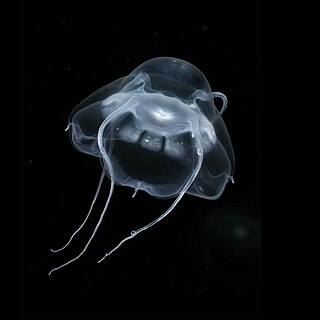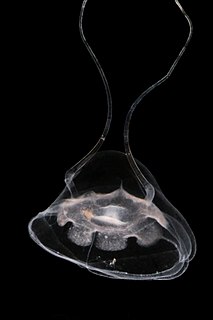
Zyzzyzus is a genus of marine tubulariid hydrozoans, which grow embedded in sponges.

Leptothecata, or thecate hydroids, are an order of hydrozoans in the phylum Cnidaria. Their closest living relatives are the athecate hydroids, which are similar enough to have always been considered closely related, and the very apomorphic Siphonophorae, which were placed outside the "Hydroida". Given that there are no firm rules for synonymy for high-ranked taxa, alternative names like Leptomedusa, Thecaphora or Thecata, with or without the ending emended to "-ae", are also often used for Leptothecata.

Haleciidae is a family of hydrozoans. Their hydroid colonies emerge from a creeping hydrorhiza and usually form upright branching colonies, although some species' colonies are stolonal. Their gonophores are typically sporosacs, growing singly or bunched into a glomulus. They remain attached to the hydroids or break off to be passively drifted away; in a few, the gonophores are naked.

Narcomedusae is an order of hydrozoans in the subclass Trachylinae. Members of this order do not normally have a polyp stage. The medusa has a dome-shaped bell with thin sides. The tentacles are attached above the lobed margin of the bell with usually a gastric pouch above each. There are no bulbs on the tentacles and no radial canals. Narcomedusans are mostly inhabitants of the open sea and deep waters. They can be found in the Mediterranean in large numbers.
Csiromedusa medeopolis is a species of hydrozoan described in 2010. It was discovered in the estuarine waters of the River Derwent near to the Commonwealth Scientific and Industrial Research Organisation's Marine and Atmospheric Research branch in Hobart, Tasmania, Australia. C. medeopolis has been described as presenting a new family and genus as well as species.

Benthocodon is a genus of hydrozoans of the family Rhopalonematidae. The genus contains two known species: Benthocodon hyalinus and Benthocodon pedunculatus, however due to the small size and red pigmentation, they can easily be confused with related genera. Unlike many hydromedusae, these jellyfish do not have a sessile stage. Rather, they spend their entire lives in the water column as plankton. The genus Benthocodon can be found near the sea floor in the Pacific Ocean from Antarctica to California to the Arctic Ocean.

Marrus orthocanna is a species of pelagic siphonophore, a colonial animal composed of a complex arrangement of zooids, some of which are polyps and some medusae. Swimming independently in the mid-ocean, it lives in the Arctic and other cold, deep waters. It is a colonial creature that is born from a single egg which is fertilized. Later on, a protozoan form that eventually grows to form more duplicating members of the colony. It belongs to the order siphonophorae and the family Marrus. Other species in the family include the Marrus antarcticus, Marrus claudanielis, and Marrus orthocannoides.

Solmundella is a genus of hydrozoan in the family Solmundaeginidae. It is monotypic, with the single species Solmundella bitentaculata.

Oceaniidae is one of the over 50 cnidarian families of the order Anthomedusae. It contains nearly 50 species in ten genera.

Aequoreidae is a family of hydrozoans. There are approximately 30 known species found in temperate and tropical marine coastal environments. Aequoreids include Aequorea victoria, the organism from which the green fluorescent protein gene was isolated.
Solmarisidae is a family of hydrozoans in the order Narcomedusae. The name is sometimes spelled "Solmaridae".

Solanderia is the sole genus of hydrozoans in the monotypic family Solanderiidae. They are commonly known as tree hydroids or sea fan hydroids.
Maeotias is a genus of hydrozoans in the family Olindiidae. It is a monotypic genus with only a single species, Maeotias marginata, commonly known as the Black Sea jellyfish or brackish water hydromedusa and often referred to as Maeotias inexpectata in the literature. It was first described from the Don and Kuban estuaries of the Sea of Azov, and also occurs in the Black Sea, all of which are areas of low salinity. It has been recorded in several other estuarine locations around the world and is regarded as an invasive species.

Aplanulata is a suborder of Hydrozoa, a class of marine and freshwater invertebrates belonging to the phylum Cnidaria. The group have lost its planula larval stage, and the only remnants of the medusa stage is when they functions as gonophores attached to the polyp.

Aglaura is a monotypic genus of deep-sea hydrozoan in the family Rhopalonematidae. It is represented by the species Aglaura hemistoma.

Persa incolorata is a species of deep-sea hydrozoan found in the monotypic genus Persa in the family Rhopalonematidae.
Tetrorchis is a monotypic genus of deep-sea hydrozoan in the family Rhopalonematidae. It is represented by the species Tetrorchis erythrogaster.

Corymorphidae is a family of hydroid cnidarians. For long placed in a presumed superfamily or infraorder Tubulariida of suborder Capitata, they are actually close relatives of the Hydridae and are now united with these and a number of relatives in a newly recognized suborder Aplanulata. Most, if not all species in this family grow on stalks and resemble small flowers.
Sertularella decipiens is a branching colonial hydroid in the family Sertulariidae.
Paracoryne is a monotypic genus of cnidarians belonging to the monotypic family Paracorynidae.













